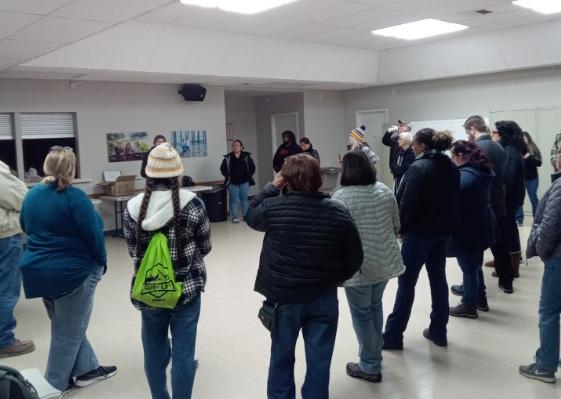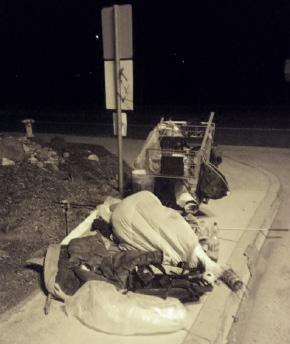
6 minute read
MORE THAN A NUMBER: LETTING THE UNHOUSED KNOW THEY COUNT
BY REV. (COL-RET.) SCOTTIE R. LLOYD
Homelessness has a face and place, but often unseen for many reasons. For some well-meaning folks, those experiencing homelessness are understood from a distance by chance or choice. But once a year people get an opportunity to experience homelessness personally.
Advertisement
Recently an army of volunteers roamed their communities’ seeking individuals and families living in ravines, battered vehicles, against abandoned storefronts, sidewalks, and makeshift encampments, wherever society temporarily allows their presence. The U.S. Department of Housing and Urban Development (HUD) requires all communities that receive federal funding for homeless programs to conduct a count of homeless individuals, which includes personal interviews. Allow me to share my experience during “counts” in San Bernardino and San Diego counties.
It’s 5 a.m. in San Bernardino, dark, cold, and our 4-person team sees our first person rolled up in a dirty, ragged sleeping bag up against a storefront in a rough neighborhood. We approach carefully and announce who we are and that we bear gifts. An old man rolls over and peers up at us with a dazed look. We try to communicate. His eyes dart back and forth processing what we represent. Suddenly, one of our team members cries out, “Uncle?”. Dropping to his knees, he embraces the still silent man. Tears flow, and they hold each other in a rocking motion. The old man’s few words and behavior indicate he is not coherent or capable of recognizing his nephew. Our team member tells us he has been hunting for his uncle on the streets for years. It’s obvious the old man will not be able to answer our questions, so we leave some gifts, ‘count him’, and thank him. Before departing, his nephew asks his uncle what he can do for him. The old man whispers, “I’m cold. My hands are cold.” His nephew, taking off his brand new gloves he bragged to us about earlier in the car, places them on his uncle’s gnarled hands. Then he kisses him and promises to return. This man looks 80, but the nephew tells us he is 55. He is way younger than me.
We continue our early morning journey. We discover a vacant lot with four tents, one at each corner of the square. A young man emerges from one of the tents and identifies himself as a former resident of my home state in the Midwest. He tells us his brother is in the tent catacorner from us. They came to California for their mother’s funeral and now have no money left to return home. They are camped out and wondering what to do.
Later, we meet a family of four, crowded in a small tent crammed underneath a freeway overpass and beside a couple of other makeshift dwellings. It is a small encampment. The ‘residents’ have clearly been there for a long time. One of the children jumps out of the tent and scurries down the uneven cement culvert to the sewage ditch and relieves himself. Milk jugs filled with water circle the area. They are more than willing to be interviewed for the chance to receive a $10 gift card and get a ‘goodies bag’ of street-living necessities.
The day drags on until the sun is high and hot. There never seems to be an end to finding more people desperately scratching for survival. Some run from us in fear of eviction or being abused. Others welcome conversation since most ‘normal folks’ refuse to speak with them. One man is a military veteran and is unaware of special help available to him. With his permission, I provide his name and information to a special resource for homeless vets. By days end, he will be housed and have multiple services offered. He thanks me repeatedly.
We move on to another wandering fellow. He is trying to find a new place to sleep for later that night. We conclude our interviews at 11 a.m. The count is at 15 people, but we pass many more uncounted souls. Both Federal and local officials know this is a snapshot in time – a bare minimum of human homelessness.
This year, I volunteered to help with the Point-InTime Count in San Diego County. It is another team of four: a couple of local residents, an observer, and myself. It’s 4:30 a.m., dark and cold. It is January, the usual month for these interview counts. I ask, 'why do we do this during the winter?' Most reply that it fits the Federal budget cycle. Local officials have until May to deposit their data, and HUD has 3-4 months to gather the information nationwide. The process is done by September and the new fiscal year begins October 1st. The money is released and, hopefully, improvements occur. In January, a new Point-In-Time Count will be made, and the cycle will repeat itself.
We drive behind buildings, check parks, and peer into vehicle windows that look like overnight shelter. We watch for the ‘walking homeless,' those have no place they feel safe at during the night. They walk in circles under lighted areas of 24-hour businesses. They will find places when the sun is up to rest and feel safer.

Our first stop is a ravine along a heavily wooded drainage creek. Thankfully, there’s some parking lot lights nearby. We meet a ‘family’ of indigenous folks from a branch of the Kumeyaay tribe, displaced from their home in the mountains. "Can’t be homeless in the mountains,” relates one man. “There’s snow up there. It’s cold here, but livable.” The man tells me that he and his sister exist in their rugged tent until Monday. Then they must find another place because they have been here a month. The police have ordered them to leave or be forced out. He and his family are kind people who answer our questions and continue to converse about their lives. Everyone wears layered clothes – their entire wardrobe. A woman walks up to us in house slippers with a coat that is dirty and smells. She smokes a cigarette. She cannot sleep, she says. She is ready to talk to get a $10 food card. It’s worth two meals for her. The socks we give her are badly needed.
Another person we approach is so quiet, still and mysteriously rolled up in a tattered blanket. We are not sure if he is dead or alive. Coins of various denominations are scattered around him. We shout and shout to get his attention, but no response, no snoring, no noise. We are not allowed to touch him. We count him and mark the location for follow-up help.
Our last visit of the morning is a dancing young man in his 30s with his all his belongings in a garbage bag next to him. He’s a kind, affable man who appears to be unable to stop dancing, twitching or moving. He readily answers our questions. He tries, but shares a challenged grasp with communication and perhaps with reality. When we leave, he resumes his sidewalk dance singing an occasional song.
More counts will be made of homeless individuals. A week is set aside to count the young (17-24), who are very difficult to reach. I am told by officials that the rewards are advertised. They are "for the taking" if the youth will come to a central location and be interviewed. It garners many and misses some. Another group of helpers will count the homeless in shelters and other institutions. Finally, more trained folks will follow up on the results we one-day volunteers have accumulated by checking unresponsive people and vehicles. All the data will be gathered, organized, and sent to HUD.
Every time I have joined this community effort, I have come away changed. The written stories and statistics meld into a flesh-and-blood person with a life. Many times, I have seen the face of Jesus among the homeless. It is one of the reasons why I volunteer with Lutheran Social Services of Southern California. Their mission at some 15 ministry sites across six Southern California counties provides Christ-motivated shelters and services to unhoused, troubled, youth, and many more. A standout example in the San Bernardino community is the Central City Lutheran Mission, an LSSSC Wellness Campus with an initiative to build a bigger and better facility for homeless men by 2025. They are provided transportation to medical facilities, job interviews, other appointments and supportive services while they reach healing and recovery.
If you want an encounter with individuals experiencing homelessness in a vitally helpful way, look for information on the January Point-In-Time Count. You can sign-up in your county of residence to participate. People of all ages join in this effort. You may even see the face of Jesus and change your life. Meanwhile, please engage and support the local initiatives in your community that house and help. Consider joining LSSSC in its efforts to go beyond counting. You can offer real-world help and recovery to homeless individuals including those you might encounter. I guarantee that your efforts can change a life and even your own.









